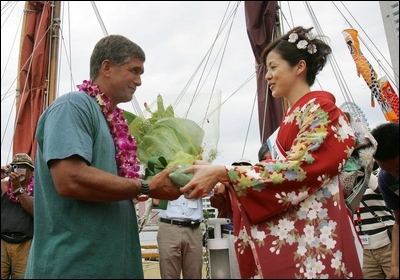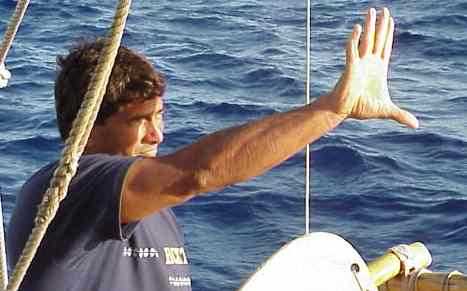Bruce Blankenfeld
Notes (2010): Bruce Blankenfeld of Niu Valley serves as crew training coordinator for the World Wide Voyage. He is employed as a foreman by McCabe Hamilton and Renny (stevedoring contractor) and is a long distance paddler and coach for Hui Nalu Canoe Club. His most recent voyage as captain and navigator was the 2009 training sail from Hawai‘i to Palmyra and back in preparation for Hokule‘a’s Worldwide Voyage. Bruce serves as a director of crew training for the voyage.
Bruce began his association with Polynesian Voyaging Society in 1977 by volunteering for the maintenance of Hokule'a while training for crew on day and night sails.
He was a crew member when the canoe swamped after leaving Honolulu in 1978. In 1979, he again worked on repairing and maintaining the canoe for a voyage scheduled for 1980.
On the 1980 voyage from Tahiti to Hawai'i (2,500 miles, 25 days), he served as fisherman, a role he was well prepared for: as a child, he accompanyied his father on fishing expeditions in Hawaiian water.

Bruce with Mahimahi, 1980. Photo by Mike Tong
During the three-year voyage to Aotearoa and back (1985-1987), Bruce again served as Hokule‘a’s fisherman, from Rarotonga to Aotearoa (1,700 miles, 17 days); from Rarotonga to Tahiti (800 miles, 8 days); and from Aitutaki to Rarotonga, Cook Islands (1 day). He began his leadership training on the final leg of that voyage, serving as both watch captain and fisherman from Rangiroa, in the Tuamotus, to Hawai'i (2,500 miles, 27 days).
In 1990, he began formal navigation training with Nainoa Thompson and Mau Plailug, which included a nine-day sail on Hokule'a out of sight of land in 1991. On the 1992 voyage to Rarotonga, he served as an apprentice navigator on Hokule'a from Rarotonga, Cook Islands to Tahiti (800 miles, 8 day) and then as co-navigator, with Kimo Lyman, from the Tahiti to Hawai'i.
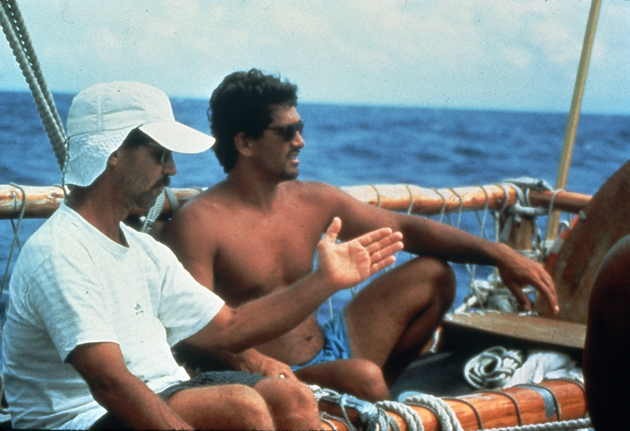
Kimo and Bruce, 1992 Voyage to Hawai‘i
Before the voyage home in 1992, Blankenfeld felt comfortable with his knowledge of the positions and paths of the sun and stars, having studied them for over a decade with his friend and mentor Nainoa Thompson. The voyage was a great learning opportunity in wayfinding for Blankenfeld – in keeping track of the canoe's position, remembering the positions of islands along the route, steering by the ocean swells, predicting the wind and weather, anticipating the movement of the moon, and measuring latitude stars with his hand. During the voyage Blankenfeld became more intimate with the ocean environment, the constantly changing clouds, winds, and swells. Observing the environment so closely to learn from it and to anticipate its changes made Blankefeld appreciate the beauty of all its elements, including overcast skies and violent squalls.
During the voyage, Blankenfeld's orientation began to change from that of a sailor to that of a wayfinder. Once, while asleep for an hour, his mind continued to follow the movements of the sky, so that when he awoke and looked up, he had a feeling of deja vu-the sky was as he had seen it in his dream. By the second week of the voyage, when he looked past the bow of the canoe, he no longer saw a trackless expanse of ocean, but a pathway or road leading home to Hawai'i. Even when the wind would not allow the canoe to sail on that road, he knew the road was there. He began to understand the confidence the ancient navigators must have felt in sailing the long sea distances of the Pacific.
From 1993-1995, in preparation for the 1995 voyage to Nukuhiva, Bruce assisted in the construction and modifications of Hawai'iloa and the Hokule‘a drydock. On the voyage to Nukuhiva, he served as co-captain and co-navigator of Hawai'iloa, with Chad Baybayan, from Hawai'i to Tahiti (2,400 miles, 21 days); and captain and navigator of Hawai'iloa from Tahiti to Nuku Hiva, Marquesas (900 miles, 8 days) and from Nuku Hiva to Hawai‘i (2,400 miles, 23 days).
That summer, he captained and navigated Hawai'iloa from Vancouver, B.C. to Ketchikan, Alaska, via the Inland Passage (850 miles, 10 days).
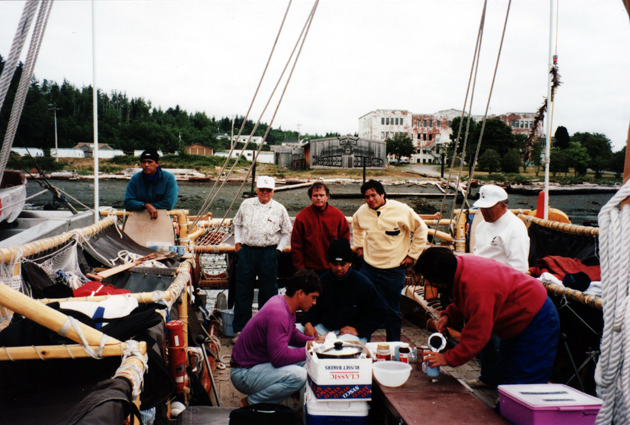
Meeting with crew at Alert Bay, British Columbia
In 1999, on the voyage of Rapanui, he captained and navigated Hokule‘a from Hawai‘i to Nukuhiva, a navigational challenge that involved sailing 900 miles upwind and finding a target screen 150 miles wide, north to south. Realizing the canoe had ended up west of the target screen, Bruce and his crew tacked for four days into the wind and signed the island of Eiao, just north of Nukuhiva.
Bruce was part of the navigational team that then guided Hokule‘a from Mangareva to Rapanui, another sail into the direction of the prevailing winds, estimated to take 30-60 days. Hokule'a found the most isolated island in Polynesia on the 19th day. After the voyage, he reflected back on it:
A lot of things have happened on this voyage that gave me chicken skin. The port hull of the canoe is the wahine hull and the starboard hull is the kane hull. The symbolism is that the male and the female forces give us life. The symbolism is that they also balance each other - they help each other survive in the ocean.
The mana in this canoe comes from all the people in the past who have sailed aboard Hokule'a and cared for her. I think of the literally thousands of people who have come down and given to the canoe when she was in dry dock. I think of Bruno Schmidt in Mangareva who showed up with his truck every morning to take us wherever we needed to go. I think of the people in Tautira and Aotearoa and the Marquesas who did the same. The list is endless. All of this malama - this caring - adds to the mana of the canoe. It is intangible but it is alive and well. We can all feel it. I just want to acknowledge it.
In this crew we have shown a nice respectful balance. We have shown that we all know how to work hard and how to treat each other well and that was one of the most memorable parts of the voyage for me. The work ethic among this crew was fabulous. There was not one negative word. This kind of caring for each other is part of the on-going rediscovery of what voyaging is all about.
After the leg to Rapanui, Bruce navigated Hokule‘a back to Tahiti via the Marquesas Islands.
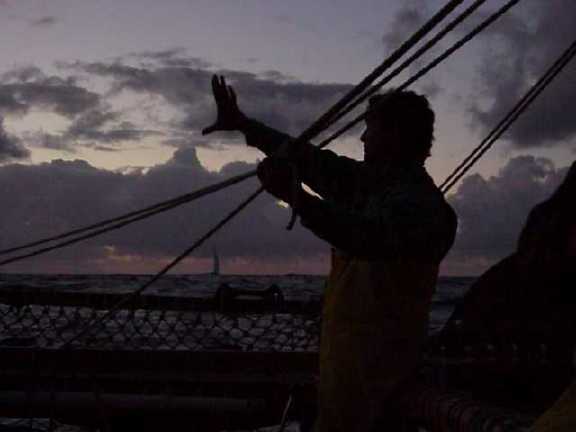
Navigating at dusk on the way to Tahiti
'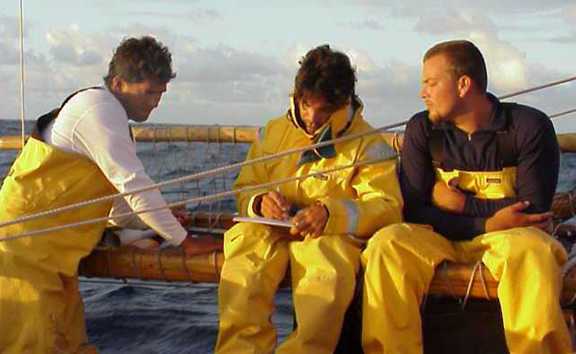
Working with apprentice navigators, Kamaki Worthington and Na‘alehu Anthony on the way to Tahiti
In 2004 Blankenfeld served assailing master for the voyage from Kaua'i to the Northwestern Hawaiian Islands, to Kure Atoll, the westernmost point of Hawai‘i; and as navigator on the voyage from Kure back to Kaua‘i.

Bruce (right) Leaving Kaua‘i with Russell Amimoto
The voyage was called “Navigating Change” to focus on creating an awareness of the ecological problems we face and making them relevant to the decisions that confront us in our daily lives:
What we're doing with 'Navigating Change' is to get people to do a little. If everybody just did a little thing, it would make a big difference. Like using biodegradable soap, because everything ultimately goes to the ocean, and all you have to do is change brands The whole spirit of malama is that you always leave a place better than you found it.
In 2007, on Ku Holo Mau, the voyage to Satawal, Bruce was captain and navigator of Hokule‘a from Hawa'i to Pohnpei. He rejoined the crew for the sail from Chuuk to Satawal, where he was one of five Hawaiians inducted into pwo by Mau Piailug.

When Hokule‘a continued on to Japan, Bruce captained her on the last leg, from Uwajima to Yokohama.
